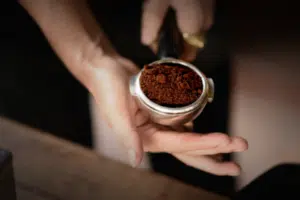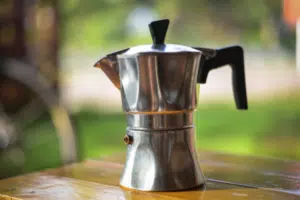What Is The Best Chemex Grind Size? 2-Minute Read
Disclosure: This post contains affiliate links and I may earn a small commission (at no extra cost to you) if you click through and make a purchase. Thanks in advance – I really appreciate it!
I fell in love with Chemex’s awesome design the first time I laid eyes on it. But beyond its beautiful design, it also creates an exquisite cup of coffee. Just like every other coffee brewing method, you need a very specific coffee grind size for Chemex too.
Key Takeaways:
What is the best Chemex grind size?
Chemex coffee brewing method calls for a medium-coarse grind size which has a texture like coarse sand. Chemex uses a coffee to water ratio of 1:16. To make coffee for two people, you will need 24 grams of medium-coarse ground coffee and 385 grams of water heated to a temperature of 195°- 205° F.
Coffee from a Chemex is very similar to that from a drip, but there’s more room for error. In the rest of this article, we will explore how you can achieve the ideal Chemex grind size, what grinder settings you should use, how to make a perfect cup of Chemex coffee.
Chemex Grind Size
It’s extremely important that you use a medium-coarse grind when you use your Chemex for making coffee.
The reason for this is that Chemex uses a specialized filter that is woven tighter than most, making it thicker overall.
Your brewing time will take longer, but your coffee will end up being smoother and lack some of the bitterness that typical brewing methods can lend.
In addition, the slower filtering time also gives you a more developed flavor.
As stated, the Chemex has a thicker filter.
This makes it important to use a medium-coarse grind as a finer grind will produce a longer brewing time that can over-extract the coffee beans.
If you use a finer grind, the grind will end up doing most of the filtering instead of the filter.
Overall, you want to aim for a brew time of four to five minutes. If your brew time is longer than this, then you should consider using a coarser grind for your beans.
Why you should grind your own coffee at home for Chemex?
When it comes to coffee flavor, freshness is king. No matter their roast or country of origin, to get the most flavor out of your beans, you’ll want them to be as fresh as they can be. This means making sure they’ve been roasted and ground as recently as possible.
As they come into contact with oxygen, coffee beans begin to lose flavor and become stale.
For that reason, freshly roasted coffee has the best flavor within one to two weeks, while freshly ground coffee starts to lose flavor 15 minutes after grinding.
So, for the best flavor, grind your beans just before brewing them.
Another reason to grind coffee beans at home is that different types of coffee brewers require varying coffee grind sizes.
If you grind your beans at home, you can easily adapt the grind size of any beans from espresso to Chemex and back again.
Best Grinder Settings For Chemex Brewing
Of everything you might encounter when brewing coffee at home, grinding coffee is arguably one of the most crucial steps, as grind size alone can dramatically change the taste of your cup.
Grind size and consistency can be the difference between one of the best cups you’ve ever had and a bitter, undrinkable mess.
To help you efficiently grind your own fresh coffee on the spot, below is a table that lists the ideal grinder settings of the most common burr grinders for brewing coffee in a Chemex.
If you don’t own a grinder yet, then make sure that you go through the next section of this article where I list down a few great grinders for Chemex coffee brewing.
| Grinders | Grind Setting |
|---|---|
| Baratza Encore | 24 – 29 |
| Baratza Virtuoso | 24 – 29 |
| Baratza Vario | 6 – 7 |
| Capresso Infinity | 10 – 12 |
| Cuisinart Supreme Grind | 11 – 13 |
| Bodum Bistro | 8 – 10 |
| OXO Brew Burr Grinder | 9 – 11 |
| Hario V60 | 26 – 32 |
| KRUPS Burr Grinder | 10 – 12 |
How To Make Coffee In A Chemex
Step 1: Select your favorite whole bean coffee you want to enjoy and grind it to medium coarse ground.
Step 2: Heat your water to 205 degrees Fahrenheit by bringing it to a boil and letting it sit for 30 seconds.
Step 3: Unfold the Chemex filter and insert it at the top of the brewer, making sure the 3-layered side of the filter is lined up with the pouring spout.
Step 4: Pour hot water around the inside of the filter for about 5 seconds. Keeping the filter in place, discard the rinse water. Rinsing the filter helps seal it inside the dripper and also gets rid of any papery taste.
Step 5: Pour your ground coffee into the filter and gently shake the brewer back and forth to settle the grounds.
Step 6: For your first pour, gently pour 60ml of water over the coffee grounds, in a circular motion. This is the preinfusion phase (what we call the bloom). It allows the coffee to de-gas a little bit and soaks in that first splash of water.
Step 7: After the grounds bloom for about 30-40 seconds, slowly pour the brewing water over the grounds while keeping the water level well below the top of the Chemex.
Slowly pour the remaining water over the grounds, using a circular or back-and-forth motion as you pour to ensure an even soaking of the grounds.
Step 8: Let the coffee drip until the coffee looks dry and is flat at the base of the brewer. If the grind size and pour rate were both correct, the coffee should finish filtering through after around a minute.
Step 9: Once the desired amount of coffee is brewed, lift the filter with spent grounds out of the brewer and discard.
Step 10: Pour your freshly made coffee from your Chemex into a mug and indulge in the flavor.
If you are still unsure about what a Chemex is or how you should use it, then check out the quick video here.
Why is coffee grind size important?
Grind size can affect the flavor and texture of your brewed Chemex coffee. It can mean the difference between delicious, flavorful coffee and tasteless, bland, or overly textured coffee.
Let me quickly explain how grind size impacts the flavor of the coffee.
No matter your brew method, coffee-making involves extracting flavor (and caffeine) from coffee grounds.
The finer you grind your coffee beans, the more you increase the exposed surface area of the grounds, resulting in faster extraction.
That’s why coffee for espresso machines is ground fine since the water from an espresso maker passes very quickly at high pressure through the grounds.
Cold-brew, on the other hand, is made with coarse-ground coffee, since this cold-extraction method allows the coffee to sit with the water for a much longer period of time.
In the middle, we have brewing methods such as Chemex that allow water to sit with the coffee grounds for a few minutes and therefore require medium-coarse coffee grinds to avoid over or under-extraction.

Amit Gupta
Hi, my name is Amit Gupta, and I am the owner and contributor at Cafeish. My obsession with coffee started when I received my first French press as a gift almost ten years ago. Since then, my love of coffee – and the number of coffee gadgets I own – has grown considerably.
Most Popular
ABOUT US
We are a team of coffee affcianados with experience and expertise in making world renowned coffee. In fact, preparing the best coffee ever with a fluffy top reminds us of magic, with secrets of how to achieve each particular effect. Making coffee is not our only hobby, we always keep our ears open as to what’s happening around and what scientists and manufacturers produce for consumers. It’s not an easy task to do – it’s rather time consuming. Hence, Caféish website was launched.
LEGAL DISCLAIMER
Caféish is a participant in the Amazon Services LLC Associates Program, an affiliate advertising program designed to provide a means for sites to earn advertising fees by advertising and linking to Amazon.com. Caféish also participates in affiliate programs with Clickbank and other sites. Caféish is compensated for referring traffic and business to these companies.




